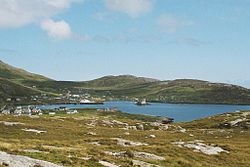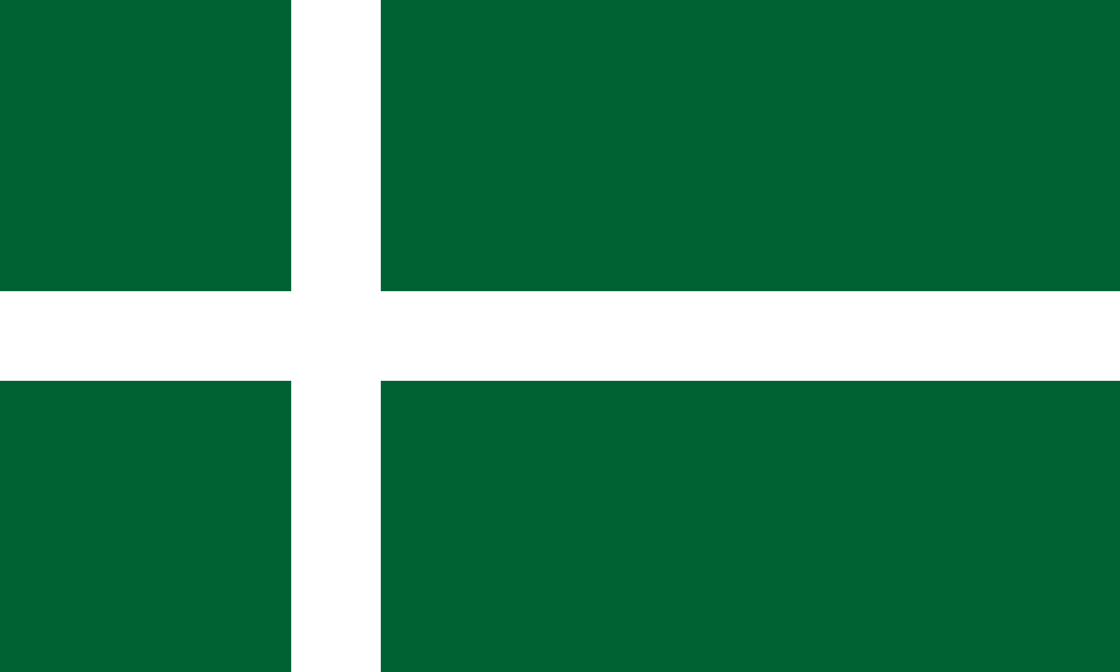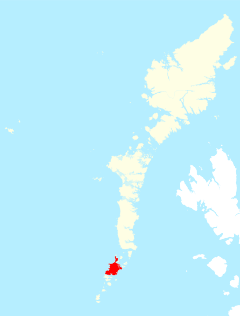Barra: Difference between revisions
mNo edit summary |
No edit summary |
||
| Line 75: | Line 75: | ||
Ferries to [[Oban]], [[Lochboisdale]], [[Tiree]] and [[Eriskay]] are run by Caledonian MacBrayne. [[Castlebay]] is the main port from which ferries sail to Oban on the Scottish mainland, Tiree and Lochboisdale on [[South Uist]]. The mainland crossing takes about 5 hours. A vehicular ferry travels between [[Ardmore, Barra|Ardmore]] and Ceann a' Gharaidh on Eriskay. The crossing takes around 40 minutes. | Ferries to [[Oban]], [[Lochboisdale]], [[Tiree]] and [[Eriskay]] are run by Caledonian MacBrayne. [[Castlebay]] is the main port from which ferries sail to Oban on the Scottish mainland, Tiree and Lochboisdale on [[South Uist]]. The mainland crossing takes about 5 hours. A vehicular ferry travels between [[Ardmore, Barra|Ardmore]] and Ceann a' Gharaidh on Eriskay. The crossing takes around 40 minutes. | ||
==Industry | ==Island flag== | ||
[[File:Isle of Barra flag.svg|right|thuumb|1120px|The island flag]] | |||
In December 2017, the Lord Lyon granted the island a patent of arms recognising an island flag: a flag of deep green with a white Nordic cross. The green is said to represent the MacNeils, who long owned the island, or Barra's links with [[Ireland]] (or its firm Roman Catholicism). The Nordic cross represents the Norse heritage of the [[Hebrides]]: the islands were a Norse kingdom for several centuries though without losing their Gaelic language. | |||
The flag was in use on the island for many years before becoming official, and used to label "Made in Barra" products. It was possibly devised in the late 1990s. Barra's flag is very similar to that of its neighbour, [[South Uist]], which uses a green flag with a blue Nordic cross fimbrated in white. | |||
==Industry and tourism== | |||
The Hebridean Toffee Factory in Castlebay is one of the few manufacturers on Barra.<ref>{{cite web| url=http://www.hebrideantoffeecompany.com| title=Heart Hebrides Toffee| publisher=| accessdate=24 July 2008}}</ref> | The Hebridean Toffee Factory in Castlebay is one of the few manufacturers on Barra.<ref>{{cite web| url=http://www.hebrideantoffeecompany.com| title=Heart Hebrides Toffee| publisher=| accessdate=24 July 2008}}</ref> | ||
| Line 96: | Line 102: | ||
File:Castlebay and the Heaval.jpg|Castlebay and Heaval, from Vatersay | File:Castlebay and the Heaval.jpg|Castlebay and Heaval, from Vatersay | ||
</gallery> | </gallery> | ||
==Outside links== | ==Outside links== | ||
| Line 107: | Line 110: | ||
*[http://www.uisgebeathananeilean.co.uk/ Barra Distillery] | *[http://www.uisgebeathananeilean.co.uk/ Barra Distillery] | ||
*[http://www.barraweather.com Barra weather] | *[http://www.barraweather.com Barra weather] | ||
==References== | |||
{{Reflist}} | |||
Revision as of 19:37, 10 December 2017
| Barra Gaelic: Barraigh | |
 Castlebay | |
|---|---|
| Location | |
| Location: | 56°58’60"N, 7°28’0"W |
| Grid reference: | NF687004 |
| Area: | 23 square miles |
| Highest point: | Heaval, 1,257 feet |
| Data | |
| Population: | 1,078 |
The island of Barra is an island of the Outer Hebrides. Apart from the adjacent island of Vatersay, to which it is connected by a causeway, is the southernmost inhabited island of the Outer Hebrides. It is a predominantly Gaelic-speaking and Roman Catholic island.
The name of the island means "Barr's island", after St Barr or St Finbarr.
Geography

The 2001 census showed that the resident population was 1,078 (1,172 including Vatersay). The area of Barra is roughly 23 square miles, the main village and port being Castlebay (Bàgh a' Chaisteil).
The west of the island has white sandy beaches backed by shell-sand machair and the east has numerous rocky inlets.
Kisimul Castle at Castlebay is located on an island in the bay, so giving the village its name. The highest elevation on the island is Heaval, halfway up which is "Our Lady of the Sea" a prominent white marble statue of the Madonna and Child. Other places of interest on the island include a ruined church and museum at Cille Bharra, a number of Iron Age brochs such as those at Dùn Chuidhir and An Dùn Bàn and a range of other Iron Age and later structures which have recently been excavated and recorded.
History

The Clan MacNeil has strong ties to the Isle of Barra and claims descent from the O'Neills of Ulster. Theirs was the castle and the whole island. Barra is thought to take its name either from Saint Finbarr, the founder of Cork, or from St Barr, the great-grandson of Niall of the Nine Hostages, the legendary 4th century king of Ireland from whom the O'Neills have their name.[1]
The motto of the Clan MacNeil of Barra in Latin is Vincere Vel Mori, which translated is "Victory or Death" or "Conquer or Die".
Alexander, Lord of the Isles granted the island to the MacNeill clan in 1427. The clan held the island until 1838, when Roderick MacNeil, the 40th Chief of the Clan, sold the island to Colonel Gordon of Cluny. Gordon expelled most of the inhabitants in order to make way for sheep farming. The displaced islanders variously went to the Scottish mainland, Australia, New Zealand, the United States of America and Canada. Barra was restored to MacNeill ownership in 1937 when the Barra estate, which encompassed most of the island, was bought by Robert MacNeil, an American architect, and 45th chief of the clan.[2]
In 2003, the ownership of the Barra Estate was passed by the owner, Ian MacNeil, to the Crown. The estate can be transferred to the inhabitants in the future if they request it. MacNeil, the 46th chief of the clan, who died in early 2010, had previously transferred Kismuil Castle to Historic Scotland in 2000.[3]
In May 2007 Channel 4's Time Team came to the hamlet of Allasdale to investigate the exposed remains of Bronze Age burials and Iron Age roundhouses in sand dunes that had been previously uncovered by storms. The programme was broadcast on 20 January 2008.[4]
The Dualchas Heritage and Cultural Centre is located in Castlebay, next to Castlebay Community School. It has various exhibitions annually, and is open throughout the year.[5]
Fèis Bharraigh & BarraFest - Live @ the Edge
Fèis Bharraigh began in 1981 when an idea was spawned to promote, encourage, foster and develop the practice and study of the Gaelic language, literature, music, drama and culture in the Islands of Barra and Vatersay. Since its inception in 1981 it has gone on to become a movement, now with 42 other feisean taking place every year throughout the land.
Following on from the success, and subsequent end of BarraLive; In 2007, Fèis Bharraigh launched BarraFest - Live @ the Edge, a two-day festival of traditional and modern Scottish music held on Tangasdale machair, literally on the edge of the Atlantic Ocean.
BarraFest generally takes place on the last full weekend of July. BarraFest 2011 will take place on Friday 29 July, and Saturday 30 July.
Appearance in popular culture
The 1949 Ealing Studios comedy Whisky Galore! was filmed on Barra. The film is based on the novel Whisky Galore by Sir Compton Mackenzie, itself a fictionalised telling of the story of the SS Politician, which ran aground with a cargo of some 50,000 cases of whisky on board in 1941. Mackenzie, who lived near the airport and died in 1972, is buried in a grave marked by a simple cross at Cille Bharra cemetery, which is situated a little way up the hillside overlooking Eoligarry jetty.[6][7] The sequel movie Rockets Galore! was also filmed in and around the island.
In the sitcom Dad's Army, Private Frazer claims to be from the Isle of Barra, which he often describes as "a wild and lonely place, y'unnerstand". Frazer is renowned for his "We're all doomed!" catchphrase. On one occasion, he relates how "a submarine was sunk in Castlebay and seven brave men were trapped. The water got higher and higher until it got to their necks. And then... terrible way to die!"
Barra is regularly featured in various television programmes on the new BBC Gaelic Channel, BBC Alba.
In 2008 the Barra RNLI Life Boat, Edna Windsor was featured on a series of stamps.[8] The first class stamp shows the 55-foot Severn class lifeboat in action in the Sound of Berneray 12½ miles southwest of Barra in a 12-foot swell with 16 knots of wind.[9]
Sports
Barra hosts an annual half-marathon called the Barrathon.[10] which is part of the Western Isles Half Marathon series. This is accompanied by a shorter fun-run for families, and younger children. A number of fund-raising events are held around this, including ceilidhs and Dances.
The Barra community holds an annual games on the island. In 2008, the Barra Games was held on the 20 July 2008.[11]
The island golf club, Comunn Goilf Bharraidh, has a 9-hole golf course that is claimed to be the furthest west in the United Kingdom. However, this title may in fact be held by one of the courses near Enniskillen in Fermanagh.
Tourists can also go sea kayaking[12] or power kiting,[13] and ample opportunities are available for keen anglers. Pony trekking is also an option, riding the rare, native Eriskay Ponies.
There is an annual hill race, where participants run up Heaval (1,250 feet) before returning down to Castlebay square. The fastest recorded time was set in 1987, and is 26.25 minutes.
Transport
Uniquely in the British Isles, Barra's tiny airport, near Northbay, uses the beach called An Tràigh Mhòr (English: The Big Beach) as a runway. Aeroplanes can only land and take off at low tide meaning that the timetable varies. Barra's airport is the only airport in the world to have scheduled flights landing on a beach.[14] The aircraft currently in operation on Barra is the de Havilland Canada DHC-6 Twin Otter, flown by Loganair on services to Glasgow and Benbecula from where connections to Stornoway are also available. There are no flights on Sundays. The beach is also a source of cockles.
Ferries to Oban, Lochboisdale, Tiree and Eriskay are run by Caledonian MacBrayne. Castlebay is the main port from which ferries sail to Oban on the Scottish mainland, Tiree and Lochboisdale on South Uist. The mainland crossing takes about 5 hours. A vehicular ferry travels between Ardmore and Ceann a' Gharaidh on Eriskay. The crossing takes around 40 minutes.
Island flag

In December 2017, the Lord Lyon granted the island a patent of arms recognising an island flag: a flag of deep green with a white Nordic cross. The green is said to represent the MacNeils, who long owned the island, or Barra's links with Ireland (or its firm Roman Catholicism). The Nordic cross represents the Norse heritage of the Hebrides: the islands were a Norse kingdom for several centuries though without losing their Gaelic language.
The flag was in use on the island for many years before becoming official, and used to label "Made in Barra" products. It was possibly devised in the late 1990s. Barra's flag is very similar to that of its neighbour, South Uist, which uses a green flag with a blue Nordic cross fimbrated in white.
Industry and tourism
The Hebridean Toffee Factory in Castlebay is one of the few manufacturers on Barra.[15]
The fish factory, Barratlantic, in Northbay is a major contributor to the island's economy.
A new venture, the Isle of Barra distillery producing around 25,000 litres a year, is planned for Borve on the west side of the island.[16] When operational it will be amongst the smallest in Scotland and the second distillery in the Outer Hebrides.[17][18]
Tourism is the main income for the majority of islanders. The main tourist season lasts from May to September. Thousands of people visit the Island every year, the busiest times are during Fèis Bharraigh & BarraFest in July.
Boat trips to the neighbouring island of Mingulay are available during the Summer season, island hopping plane trips are also available.
Gallery
-
Castlebay, Barra
-
Traigh Eais
-
Sunset From Traigh Eais
-
Airport Sands
-
Barra Airport
-
Twin Otter Taking off From Barra Airport
-
Castlebay and Heaval, from Vatersay
Outside links
- Isle of Barra community website
- Explore the Isle of Barra
- Ferry Operator Caledonian MacBrayne
- Isle of Barra Accommodation, Activities and Events
- Barra Distillery
- Barra weather
References
- ↑ "MacNeill of Barra History". ScotClans. http://www.scotclans.com/scottish_clans/clans/macneill_of_barra/history.html. Retrieved 1 April 2010.
- ↑ "Barra". Undiscovered Scotland. http://www.undiscoveredscotland.co.uk/barra/barra/index.html. Retrieved 4 November 2007.
- ↑ Ross, John (6 September 2003). "A gift to Scotland - the isle of Barra". The Scotsman. http://thescotsman.scotsman.com/index.cfm?id=980092003. Retrieved 4 November 2007.
- ↑ "Barra, Western Isles". Time Team. http://www.channel4.com/history/microsites/T/timeteam/2008/barra/index.html. Retrieved 21 January 2008.
- ↑ "Dualchas". Comunn Eachdraidh Bharraidh agus Bhatarsaidh. http://www.barraheritage.com/dualchas.htm. Retrieved 29 March 2008.
- ↑ "Whisky Galore!". screenonline.org.uk. http://www.screenonline.org.uk/film/id/441458/. Retrieved 29 March 2008.
- ↑ "Grave of Compton MacKenzie, Eolaigearraidh, Barra" Photograph NF 7007. Geograph. Retrieved 4 April 2010.
- ↑ "Set of stamps honours the courage of Britain's lifeboatmen and coastguards". London: The Times. 13 March 2008. http://www.timesonline.co.uk/tol/news/uk/article3542758.ece. Retrieved 26 December 2008.
- ↑ "Royal Mail Stamps 'Mayday - Rescue at Sea'". news.hmmm-uk.com. http://news.hmmm-uk.com/2008/03/royal-mail-stamps-mayday-rescu.html. Retrieved 26 December 2008.
- ↑ "Barrathon". barrathon.org.uk. http://www.barrathon.org.uk/index.html. Retrieved 29 March 2008.
- ↑ "Isle of Barra Events". Barra Accommodation. http://www.barra-accommodation.co.uk/events.php. Retrieved 21 March 2008.
- ↑ "Clearwater Paddling". http://clearwaterpaddling.com/. Retrieved 29 March 2008.
- ↑ "Barra Power Kiting". http://www.barrapowerkiting.co.uk/. Retrieved 29 March 2008.
- ↑ "Barra Airport". Highlands and Islands Airports Limited. http://www.hial.co.uk/barra-airport.html. Retrieved 6 April 2009.
- ↑ "Heart Hebrides Toffee". http://www.hebrideantoffeecompany.com. Retrieved 24 July 2008.
- ↑ "Isle of Barra Distillery". http://uisgebeathananeilean.co.uk/home.html. Retrieved 29 March 2008.
- ↑ "Map of Scotch Whisky Distilleries". http://www.scotch-whisky.org.uk/swa/71.html. Retrieved 6 April 2009.
- ↑ "Western Isles Distillery". http://www.abhainndearg.co.uk/. Retrieved 21 June 2009.







